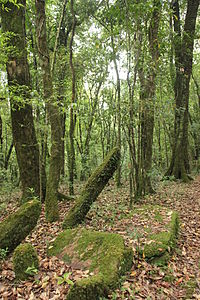
Photo from wikipedia
In an era of rapid urban growth, conserving biodiverse urban green spaces is challenging, especially in developing countries. Culturally protected areas including sacred sites are known to contribute to biodiversity… Click to show full abstract
In an era of rapid urban growth, conserving biodiverse urban green spaces is challenging, especially in developing countries. Culturally protected areas including sacred sites are known to contribute to biodiversity conservation in semi-urban and rural areas, but their role in dense urban settings is critically understudied. We, therefore, assessed biodiversity patterns of two types of Hindu places of worship (temples, kattes) and underlying environmental parameters in the Indian megacity of Bengaluru. We analyzed how variables of the urban matrix (age of development, housing density) and type of sacred sites related to biodiversity measures (species abundance, richness, beta diversity), differentiated for cultivated, spontaneous (i.e., wild growing), native and non-native plant species. Native species prevailed in cultivated (66%) and spontaneous (93%) species assemblages, and urbanization parameters significantly related to some biodiversity measures. Beta diversity was highest in sacred sites located in the newest quarters, while abundance of cultivated and non-native species increased with decreasing housing density. Higher richness in low density (i.e., wealthier) quarters demonstrates ‘luxury effect’ for sacred sites. Plots in temples showed higher diversity measures than in kattes, likely due to different management practices. While results demonstrate effects of urbanization on biodiversity measures for temples and kattes, these sites still function as habitats for native species in Bengaluru – and not as foci for invasive alien species as noticed for other urban green spaces. We conclude that urban sacred sites allow people to benefit from multiple ecosystems services and thus play an important role in the urban green infrastructure of quickly growing megacities.
Journal Title: Urban Ecosystems
Year Published: 2018
Link to full text (if available)
Share on Social Media: Sign Up to like & get
recommendations!